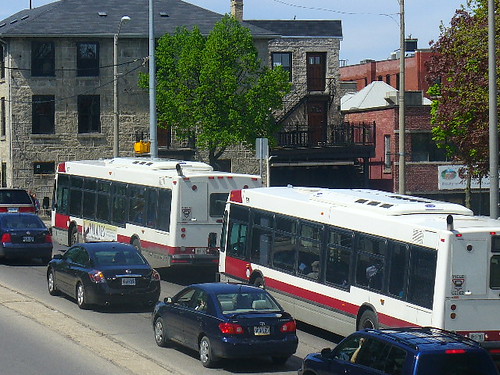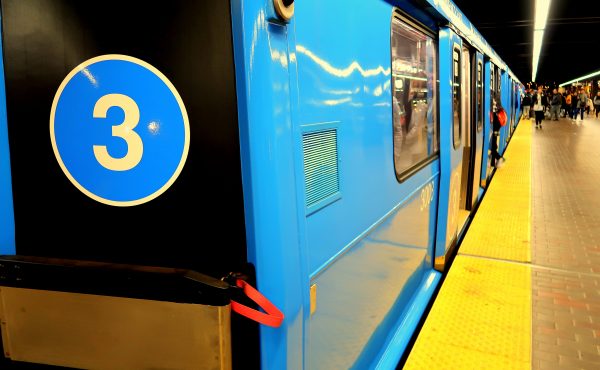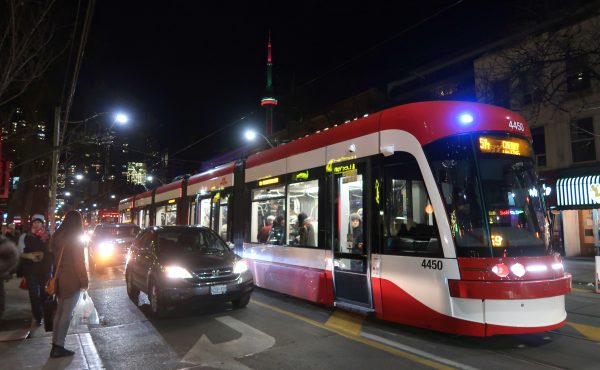
Spacing Wire reader Denis Agar alerted us to changes to Guelph Transit in September that will inconvenience most transit riders. For years, Guelph Transit has run a simple radial bus system that was easy to use. Buses run every 30 minutes, all day, every day, until 11PM Monday-Saturday and 8PM Sunday, and all buses would meet downtown, making transfers easy. Bus stop signs along the route simply say the times past the hour the bus would arrive. Recent changes included running a perimeter route that complemented the radial system and improvements to the major transit draw of the University of Guelph.
But urban sprawl on the edges of Guelph (which grew by 8.3% to a population of 115,000 between 2001 and 2006) and increased traffic has made it harder to provide schedule adherence and guarantee the connections at the Downtown Guelph hub at St. George’s Square. Bus routes are extended to serve new subdivisions, and more traffic lights and traffic contribute to the problem. As Guelph sees it, the solution is to cut service levels from every 30 to every 40 minutes when ridership is the greatest — in the morning rush hour, and from 1PM to 7PM.
In an article in a local paper, Guelph Transit is partly justifying the changes in order to not rush some passengers: “Our aging and disabled population often feel stressed and hurried to embark, disembark or make their transfer to a connecting bus.”
Guelph Transit says that decreasing service will improve the ability of elderly and disabled persons to use transit. But reports of overcrowding on some routes and the confusion caused by moving a way from a simple scheduling system that varies by the time of day are counter-arguments to this explanation.
A large portion of Guelph Transit’s ridership is made up of students who attend University of Guelph, the local Conestoga College campus and area high schools. Guelph offers frequent services (15 minutes or better) between downtown and the university. But reducing service to all the other routes that feed into the university will diminish the overall network and could result in long waits at the downtown transfer point.
There are solutions. Back in 2005, Guelph ran an experimental 15-minute service on most routes in the peak period to boost ridership. Therefore one idea would be to run buses every 20 minutes instead of every 30 minutes at peak periods, addressing increased travel times as well as actually providing more service in the peak. More complex solutions would be to reconfigure the route structure from a radial to a grid system, or separate some of the longer routes into more manageable circuits. Yet another would be to run buses in outer areas into secondary hubs. But unfortunately, the easiest and cheapest solution for the City is being taken.
For those interested, Denis has also created a Facebook Group for this issue with more details.
photo by Steve Petric




8 comments
Back When I lived in the area, I was told that the man who did the street plan for Guelph was an alcoholic, and he designed the city in a star shape because it was the shape of his hand on the map.
It is probably just an urban legend, but I was just illustrating that the city has a radial design, so the radial bus routes may provide better service than a grid.
Guelph should allow a one hour stop over for passengers transfering at St. George’s Square. Not only would this ease the level of mayhem when people are frantically trying to catch their next bus (something that was crazy when I took Guelph Transit as a student in the late 1980s) but it may also have the effect of boosting economic development in the downtown through transit users stopping in to shop/eat/spend during their alloted one hour transfer. I can’t see how Guelph Transit would loose money on an extended transfer, it can only be a postive for the city and the passengers.
An hour is a long time out of a person’s day — everyday. A prohibitive deterrent to even taking transit maybe?
“Guelph should allow a one hour stop over for passengers transfering at St. George’s Square.”
They do.
“An hour is a long time out of a person’s day  everyday. A prohibitive deterrent to even taking transit maybe?”
They don’t force people to wait an hour.
That is quite possibly the worst transit “solution” I have ever heard. Guelph’s transit was only adequate for getting downtown when I lived there (any other destination in the City would require a transfer downtown and thus end up being about a 1 hour trip), and pushing it to a 40-minute schedule, instead of 15-20 minutes where it should be will make it useless even for that.
It’s such a bizarre decision as well… if they want to keep a radial hub system, Stone Road Mall already acts as a secondary hub in the southwest end where most of Guelph’s growth is concentrated. It would make so much more sense to just split the system into two sections, one that congregates at St. George’s Square and another at the mall.
Of course, what would make even more sense is some proper route analysis and the introduction of many more circumferential routes so people can go directly where they want to.
Let me start by thanking you for drawing attention to such an important issue. I live in the South end of Guelph, and take the bus to and from work every day. Because my office is located on the other side of the city I need to make the transfer in St. George’s square everyday. This has always been convenient given that the current system ensures that all buses depart the square at the same time twice each hour. Buses that arrive early wait longer and buses that arrive late hardly wait at all. Seeing all of these machines parked in the square twice each day is a little disconcerting, not to mention noisy, ugly and a little dangerous. I would happily give up the convenience of scheduled transfers for the convenience of more buses on the road. Keeping the system moving would also have the added benefit of reducing congestion in the square. The solution is not slower service but faster.
I was part of the 2003 Guelph Transit Advisory Commitee, and while it was suspose to advise Transit management, it never really did because Management never really gave the members any real say. they once told us about a route change that had already been annouced in the media. Usually Management would run it by the Advisory Committee but chose not too.
I felt that the Advisory Committee was a joke and not give any real role to making transit better.
It was sad to see the group have to fold due to membership numbers, but now is the time to restore that group.
On top of all this, Guelph Transit has had so many plans on improving service and consultations with riders that it boggles the mind why most of these reports go unused and Management choses what it wants to do no matter what the public thinks.
It is time to bring back the Guelph Transit Advisory Committee, and to go through all the reports over the years on transit improvements and be more open to the public.
Check out my blog for some articles on Transit.
As it stands now, most bus routes in the City leave and return to the square downtown. With the increase in ridership and size of our city I believe we may have reached the limits of our current radial configuration.
With the current radial design ALL of our buses must wait for the slowest bus to arrive and transfer passengers before leaving the downtown, as such the whole system must accommodate the weakest link.
In addition this built in inefficiency; the radial system as we currently have fails to provide direct transportation to and from the various neighborhood commercial centres throughout the city.
One possible solution – http://www.ward4guelph.ca/2007/08/10/transit-improvemernts/